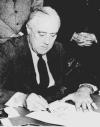 U.S
Involvement
U.S
Involvement




















 The
bombing of Pearl Harbour propelled the United States into WW2:
The
bombing of Pearl Harbour propelled the United States into WW2:
Admiral Isoroku
Yamamoto, commander-in-chief of Japan's Combined Fleet, had to be careful
of his country's position in the Pacific. If he concentrated his forces
too much in the Pacific islands, then the mainland would be more susceptible
to attack from Europe and even the United States. Yamamoto devised a plan
that involved an opening blow to the United States Pacific Fleet at the
same time as their offensive against British, American, and Dutch forces
in Southeast Asia. He planned to cripple the United States while he quickly
conquered much of Southeast Asia and gathered their natural resources.
He hoped that his attack against the Pacific Fleet would demoralize the
American forces and get them to sign a peace settlement allowing Japan
to remain as the
power in the Pacific
. A month after the British attack on Taranto harbour, Yamamoto decided
that if war with the United States was unavoidable he would launch a carrier
attack on Pearl Harbour. In January of 1941, Yamamoto first began to commit
to this strategy by planning out h is attack and showing it to other Japanese
officials. Yamamoto developed the following eight guidelines for the attack:
Surprise
was crucial
American aircraft
carriers there should be the primary targets
U.S. aircraft there
must be destroyed to prevent aerial opposition
All Japanese aircraft
carriers available should be used
All types of bombing
should be used in the attack
A strong fighter
element should be included in the attack for air cover for the fleet
Refuelling at sea
would be necessary
A daylight attack
promised best results, especially in the sunrise hours.
Many of Japan's Navy
General Staff were in opposition to Yamamoto's plan, but they continued
to prepare for the attack. All of the necessary training was given to troops,
and all of the fighters and submarines were prepared. On December 6, 1941,
President Roosevelt made an appeal for peace to the Emperor of Japan. Not
until late that day did the U.S. decode thirteen parts of a fourteen part
message that presented the possibility of a Japanese attack. Approximately
9 a.m. (Washington time) on December 7,1941, the last part of the fourteen
part message was decoded stating a severance of ties with the United States.
An
hour later, a message
from Japan was decoded as instructing the Japanese embassy to deliver the
fourteen part message at 1 p.m. (Washington time). The U.S., upon receiving
this message sent a commercial telegraph to Pearl Harbour because radio
communication had
been down. At 6 a.m. (Hawaiian time) on December 7,1941, the first Japanese
attack fleet of 183 planes took off from aircraft carriers 230 miles north
of Oahu. At 7:02 a.m., two Army operators at a radar station on Oahu's
north shore picked up Japanese fighters approaching on radar. They contacted
a junior officer who disregarded their sighting, thinking that it was B-17
bombers from the United States west coast. The first Japanese bomb was
dropped at 7:55 a.m. on Wheeler Field, eight miles from Pearl Harbour.
The crews at Pearl Harbour were on the decks of their ships for morning
colours and the singing of The Star-Spangled Banner. Even though the band
was interrupted in their song by Japanese planes gunfire, the crews did
not move until the last note was sung. The telegraph from Washington had
been too late. It arrived at headquarters in Oahu
around noon (Hawaiian
time), four long hours after the first bombs were dropped.
 Pictures
Pictures

















 President F.
Roosevelt
President F.
Roosevelt









































 U.S
Involvement
U.S
Involvement
 U.S
Involvement
U.S
Involvement
Pictures